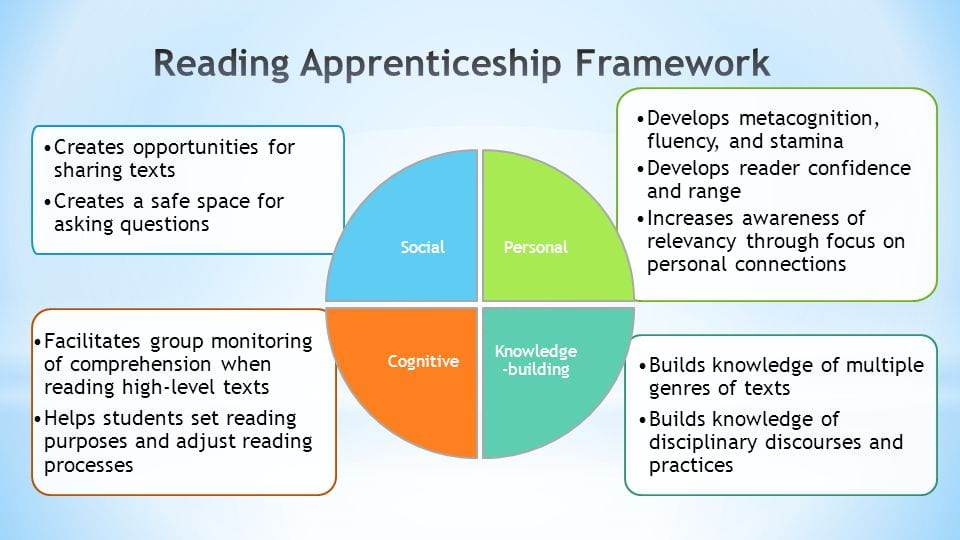
Hello Everyone!
My name is Dr. Rayna Friendly, and I am back again with a recap from SJSU’s November 2019 Teaching Community of Practice* (TCoP) Meeting.
This month’s guest facilitator was Alla Petrosyan (Technical Writing & English Instructor in SJSU’s Engineering Department), who recently completed RA (Reading Apprenticeship) training at Mission College and would love to share with the SJSU community how you could apply RA when teaching within your own discipline!
Below, I recap some of the valuable information Alla shared with us. Alla is also open to being contacted with any questions related to this topic, and her email is: alla.petrosyan@sjsu.edu.
What is Reading Apprenticeship (RA)?
- “Reading Apprenticeship is an approach to reading instruction that helps students develop the knowledge, strategies, and dispositions they need to become more powerful readers. It is at heart a partnership of expertise, drawing on what teachers know and do as discipline-based readers, and on adolescents’ and young adults’ unique and often underestimated strengths as learners.” (Reading Apprenticeship Strategic Literacy Initiative, WestEd, 2005, pg. 9). The point, I understand from this is viewing our students as “Reading Apprentices”, who learn from their teachers how to enhance their reading practice.
- “Reading Apprenticeship helps students become better readers by:
- Engaging students in more reading—for recreation as well as for subject area learning and self-challenge;
- Making the teacher’s discipline-based reading processes and knowledge visible to students;
- Making students’ reading processes, motivations, strategies, knowledge, and understandings visible to the teacher and to one another;
- Helping students gain insight into their own reading processes; and
- Helping them develop a repertoire of problem-solving strategies for overcoming obstacles and deepening comprehension of texts from various academic disciplines” (Reading Apprenticeship Strategic Literacy Initiative, WestEd, 2005, pg. 9) (For more information, see: https://readingapprenticeship.org/our-approach/ )
Why is RA important?
- Alla explained that workshops on RA were set up by her colleagues at Mission College in order to address a gap in reading abilities that have been noticed for many of today’s college and university students. She highlighted that reading is such an important skill to help students’ learning process, yet higher education has reduced the amount of mandatory classes students need to take on reading skills. This, coupled with access to so much information online available to students at a moments’ notice, often leads to students not getting the same practice on reading strategies that may have existed in the past.
- Alla also spoke to the expectations/assumptions teachers often have of their students, pointing out that we often expect students have certain basic writing and reading skills once they reach college, yet, they may in fact not have these skills (or at least, not many formal opportunities to practice these skills).
- Thus, RA is a great framework for teachers to utilize in their courses, to help increase opportunities for students to work on and enhance their reading (and related) abilities!
What are some of the RA strategies teachers could try using in their courses?
- Teachers can practice reading challenging/unfamiliar texts in front of their students, explaining the strategies they use!
- This helps students see that even the teacher struggles sometimes when reading new material and encourages the teacher be “vulnerable” in front of their students. This helps students fell more confident to try reading practices, especially in front of peers or the teacher, without so much worry that others are judging them.
- Additionally, this lets teachers demonstrate the strategies they use when faced with difficult terms/texts!
- For example, I often do this in my Research Methods class: I show the students how I go about reading Scholarly academic articles, which parts I skim over, and which parts I pay closer attention to. I also point out to them when something confuses me (such as a new term), and how I go about reducing this confusion (e.g., look up the term, re-read the sentence more slowly and out loud, etc.).
- Karin, a lecturer at this meeting, also pointed out how something like this could help reduce the self-consciousness or anxiety she sees in many of her students.
- Read, then summarize!
- Because Alla teaches writing, she often has students do readings with the clear expectations that they will have to summarize the reading afterward. Sometimes these summaries are shared with peers, other times, she may have students read, then think out load trying to make sense out of what they just read.
- Other strategies include, but are not limited to: Reading titles; Skimming; Looking for bolded/underlined words; Looking at the Pictures; Making reading part of the “class commitment” statement; Peer-to-peer reading activities.
How can I learn more about RA?
- Contact Alla Petrosyan to ask about her experiences using this framework, as well as learning about courses and workshops available (alla.petrosyan@sjsu.edu)
- https://readingapprenticeship.org/our-approach/our-framework/
- https://rtc.instructure.com/courses/1056743/pages/what-is-reading-apprenticeship?module_item_id=10740537
—
*What is the TCoP, you ask?
- The Teaching Community of Practice (TCoP) is a group for part- and full-time SJSU faculty (of all levels, across all departments), who are interested in enhancing their respective teaching practices. The TCoP will meet regularly, according to members’ schedules, to exchange strategies, tips and resources that have led to successful (and sometimes, less-than-successful) teaching experiences. Please fill out this form if you are interested in joining this community and you will be added to the groups’ mailing list. For inquires about the TCoP, please contact me at rayna.friendly@sjsu.edu.